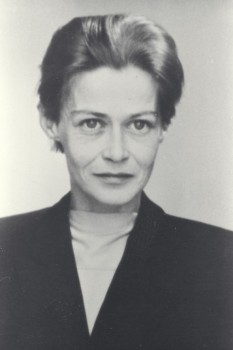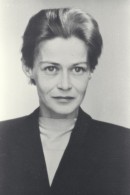Dreaming a dream: the poetry of Helvi Juvonen
17 May 2010 | Authors, Reviews

Helvi Juvonen (1950s). Photo: WSOY
The work of Helvi Juvonen is beguilingly strange; intense, eccentric, askew, it sees the world afresh. It charms by means of fairy-tale motifs and apparent nonsense; but it also offers piercing insights into suffering, loneliness, and alienation.
It combines the haunting, elliptical quality of the verse of Emily Dickinson, the nineteenth-century American poet-recluse, with the sharp, fresh imagery of the Finnish 1950s modernist Eeva-Liisa Manner. Its religiosity is complex and unsettling, its humour sly and bizarre. Hard to categorise, Juvonen is both traditional and modern: a sceptical believer, a quiet transgressor.
Juvonen (1919–1959) was known as ‘Nalle’ (teddy) as a child, and her fondness for and identification with animals emerges often her poems:
The mole sleeps,
spade-paw,
velvet-fur,
dreaming a dream, darkly soft
The poetry is also characterised by a fairy-tale logic and a kind of childlike anarchy; a goblin shares her joy with a bumblebee, a tapir talks to a stone. There is a mischievous, surreal streak in the work. The world is anthropomorphised, as in a fairy tale; the poet addresses a singing kettle.
Juvonen in fact wrote fairy tales, not published in her lifetime, like that of Little Bear dreaming as she hibernates. ‘Bon bons, bon bons,’ she says repeatedly, this stream of sound constituting joyous nonsense, an acknowledgement of the miraculous freshness of the world.
And yet, Juvonen’s poetry is sometimes seen in Finland as a poetry of suffering and of intense, even forbidding, religiosity. There is indeed a prayerful longing in much of the work, and the poems feature frequent repetition, which creates a hypnotic, liturgical effect. But God is depicted here as an intimate, to whom the poet makes suggestions:
Then I will say it to Him,
then I will say it:
Let’s play that new game now,
the one in which we are happy
and everywhere.
(‘A new game’, 1952)
God is a potential playmate, with whom one can negotiate – although the playfulness of the poem is mitigated by a wistful, mournful note; it is only in a make-believe world that God and the speaker can be ‘happy / and everywhere’. Juvonen’s unorthodox faith can perhaps best be viewed in pantheistic terms, since it is through nature that God is perceived in the poems; ‘heaven’s weeping’ appears as glints on leaves. Nature is a manifestation of the divine, and a source of wonder: ‘But think that in early April someone will find the first blue anemone of the spring. Is that not wonderful?’ The poet appeals to the here and now; in ‘In this life’ (as opposed to the next), she rejects a far-off hereafter and suggests that paradise could be earthly:
In that land, the land of which I sing,
ravens fly, bringing food.
In that land, the land of which I sing,
there is always a hand for a human hand.
In an article entitled ‘Images of isolation’ by Soila Lehtonen published in Books from Finland 1/1992, Juvonen’s work is likened to that of Emily Dickinson. The comparison is not unfounded, for the poets have in common a controlled yet intense quality, and they combine spiritual concerns with a sharp focus on the natural and the everyday. Juvonen admired Dickinson and translated some of her poems; in an essay of 1958 she termed Dickinson’s poetry tender, humorous, intense, calm, matter-of-fact, and analytical. As in Dickinson’s work, in Juvonen, small details appear magnified and acquire a vast symbolic significance. Juvonen’s most famous poem is a prime example:
The lichen raised its fragile cup,
and rain filled it, and in the drop
the sky glittered, holding back the wind.
The lichen raised its fragile cup:
Now let’s toast the richness of our lives.
(‘Cup lichen’, 1952)
Such stark, marvelling poems were written in the context of a difficult life. According to ‘Images of isolation’, Juvonen lived in ‘the drab surroundings of post-war Helsinki’, where, after studying at Helsinki University, she occupied posts as a bank clerk and a proof reader, before earning her living as a writer and translator. Her life was ‘circumscribed’, ‘often penurious’, and characterised by solitude and suffering; Juvonen underwent mental and physical illness and died at the age of 39.
But the isolation reported here is exaggerated; Juvonen lived with a female companion, Sirkka Meriluoto, for about ten years. This partnership offers interesting points of departure as far as biographical readings of Juvonen’s work are concerned. In an article about Juvonen in the Finnish newspaper Helsingin Sanomat (27 October 2009), the poet Vilja-Tuulia Huotarinen detects in Juvonen’s poems signs of hidden homosexual experience. The sense of precariousness and dividedness in Juvonen’s poems is powerful and multivalent, whatever its precise, ‘actual’ cause. The poems present vivid metaphors for unease and instability, as in ‘The tightrope walker’:
Two summits rose up above the dark.
Between them,
taut as a bow’s arc
the walker’s rope is strung.
If you look into the dark, dizziness strikes.
You need to have brains of ice.
I see the summits, both ablaze.
Back and forth, back and forth!
Such evocations of dividedness can be read in numerous ways, as expressions of the modern, alienated, urban individual; of the female writer, that recent invention; of the queer subject, forced into hiding; or the believer whose faith has been challenged. The sense of being in between can also be linked to Juvonen’s place in literary tradition, for she was a poet at the cusp of modernism.
Modernism came to Finnish poetry in the 1940s and 1950s; at this time, formal restraint slowly gave way to freer forms. Juvonen’s poetry combines technical formality with startling imagery and a clear, direct voice. It moves between rhyme and free verse and forms a bridge between ‘tradition’ and modernism.
Helvi Juvonen published five collections of poetry between 1949 and 1955; a sixth was published posthumously in 1959, and in 1974, a collection of prose works, edited by Mirkka Rekola, came out.
As 2009 marked a number of anniversaries – 90 years since Juvonen’s birth, 50 years since her death, and 60 years since her debut collection, Kääpiöpuu (‘Dwarf tree’) – her collected poems, Aukea ei koskaan metsään ovi (‘The door to the forest never opens’, WSOY) was also published; the volume includes other writings by the poet as well as critical and biographical material.
The recent anniversaries have meant a timely renewed focus on Juvonen’s work, which asks us to attend to that which is usually hushed up and overlooked; to sharpen our senses; and finally, to ‘toast the richness of our lives’.
Tags: literary history, poetry
2 comments:
Leave a comment
Also by Emily Jeremiah
Moomins, and the meanings of our lives - 21 December 2012
-
About the writer
Emily Jeremiah (born 1975) is a Lecturer in German at Royal Holloway, University of London. She is the author of academic books, articles, reviews and fiction. In 2009, Waterloo Press published Bright, Dusky, Bright, her acclaimed translations of poems by the Finnish poet Eeva-Liisa Manner, and in 2012 Peirene Press published The Brothers, a novel by Asko Sahlberg, translated by Emily and Fleur Jeremiah.
© Writers and translators. Anyone wishing to make use of material published on this website should apply to the Editors.


19 May 2010 on 2:59 am
Thanks for this. Now I feel I must find some more Juvonen poems to read.
27 May 2010 on 1:48 pm
Another fine introduction to a poet I’ve not heard of, but glad I have now I was particularly struck by the comparison to Dickinson, another poet whose isolation is all too often ‘exaggerated’ at the expense of the sheer joy, transcendence and eroticism that tears through many of her poems. I thought of THIS Dickinson when I read ‘The tightrope walker’; there’s fierce light in the blazing summits to counter the darkness beneath (and melt the ‘ice’ of the brain), sexual vigour in the ‘back and forth, back and forth’ repetition – a tightrope walker getting their kicks despite divisions, perhaps? Wonderfully multivalent as you say – thanks for the intro!